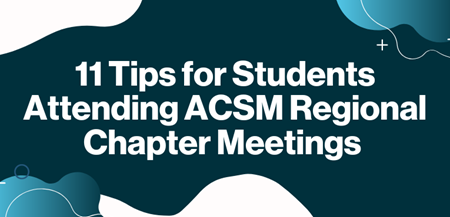Bhibha M. Das, Ph.D., MPH, FACSM, and Katherine (Katie) E. Spring, M.S. |
Sept.
22, 2022

One of the best parts of being a faculty mentor is taking students to regional conferences. You get to show them inspiring scientific content and introduce them to peers and colleagues who share their passion for sports medicine and exercise science.
If you’re planning to take students to an ACSM regional chapter meeting, consider these tips to help maximize their conference experience.
1. Review the conference program beforehand.
Conferences can be overwhelming, but reviewing the program before you attend helps set you up for success. This is especially important for first-time attendees. Discuss the different types of sessions (e.g., symposium, tutorial, thematic poster) with your students and help them choose which sessions they want to attend. You can even highlight a few presentations that you personally plan to attend or that you think would be good for your students to check out.
2. Have your students think about their goals for the conference.
Ask your students why they are attending the conference and what they hope to accomplish there. Having goals will allow them to be more intentional with their meeting experience.
3. Help them develop a personal “elevator pitch.”
As faculty, we all have our own “elevator pitches.” We’ve been doing our work for a while and understand what role we play in the advancement of our field. Our students, however, are relatively new to the discipline and may not know exactly who they are as professionals and what they hope to accomplish. Ask your students to think about who they are, what they’ve accomplished, and what they hope to do next in the context of our field.
4. Remind them it’s okay to step out of one presentation to attend another.
Often, there are several interesting presentations going on at once. Remind your students it’s perfectly fine to step out of one presentation to attend another. Just try to be respectful — sit in the back or close to the aisle, and try to move when the speakers are switching.
5. Encourage them to show up to their lab mates’ sessions.
Remind your students that friendly faces in the audience help calm nerves, and that they’d want the same support.
6. Remind them to talk with the conference’s student representatives.
The student representatives are great contacts. At SEACSM, our student reps help answer questions about where sessions are located and also put on a 5K —and this year we are looking to do a student bingo game to help encourage students to meet peers and other conference attendees.
7. Ask your students to identify one or two presenters they would like to network with personally.
Networking is one of the most important things students can do for their careers because you never know when you’ll meet someone again, especially in our field! Encourage your students to meet one or two new people, learn more about their research and find common ground. Encourage them to talk about research, but also try to make a personal connection — finding something they have in common outside of academia can help students feel more at ease and like they belong.
8. Encourage them to say yes to opportunities that might arise.
You never know where one “yes” will lead you. Encourage your students to make connections with researchers outside of your school. It could jumpstart their career.
9. Remind your students to follow up with people they connected with.
While making connections at the conference is important, you need to follow up on them. Make sure your students find a way to connect with contacts after the conference, whether via LinkedIn or email. Faculty should also consider creating an easy way to provide people with their contact information, like a QR code that links to a PDF that includes their abstract, email address and Twitter handle.
10. Check in with your students.
Conferences can be a little overwhelming. Take the time to check in with your students and see how they feel the event is going.
Bhibha M. Das, Ph.D., MPH, FACSM, is a public health and physical activity practitioner and researcher with over a decade of experience in the field. Prior to joining academia, she spent four years working with communities, including underserved and rural ones, to develop, implement and evaluate physical activity promotion programs and policies. Dr. Das’s research agenda focuses on physical activity promotion as the cornerstone for improvements in quality of life in a variety of populations. Das earned degrees in public health and kinesiology from the University of Illinois and is currently an associate professor in the Department of Kinesiology at East Carolina University as well as a fellow of the American College of Sports Medicine® (ACSM). She also serves as member-at-large in the Southeast Chapter of ACSM (SEACSM).
Katherine (Katie) E. Spring, M.S., is a doctoral candidate in Dr. Danielle Wadsworth’s Exercise Adherence and Obesity Prevention Lab at Auburn University. While at Auburn, she has been elected to serve as student representative for SEACSM as well as ACSM’s Student Affairs Committee. She received her master’s and bachelor’s degrees from Mississippi State University. Prior to attending Mississippi State, she received her associate’s degree from Holmes Community College, where she also played for the college tennis team. Her research primarily focuses on the effects of physical activity and play on physical, behavioral and learning outcomes in young children.